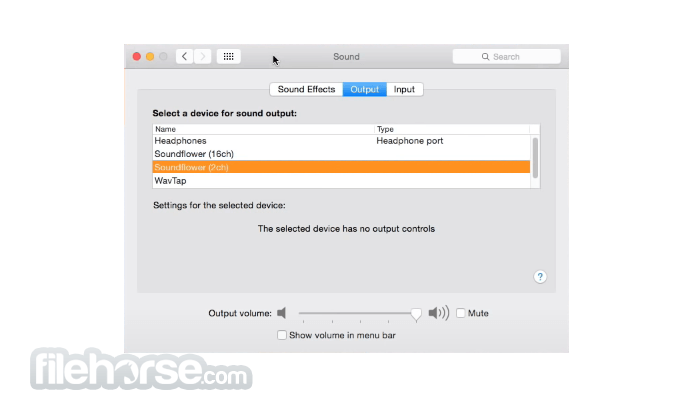-
Latest Version
Soundflower 2.0 Beta 2 LATEST
-
Review by
-
Operating System
Mac OS X 10.6 or later
-
User Rating
Click to vote -
Author / Product
-
Filename
Soundflower-2.0b2.dmg
It presents itself as a virtual audio device, enabling users to channel audio from one application to another with ease, thus enabling advanced sound management without the need for any expensive software or complicated procedures.
If you've previously used Soundflower, or are simply looking for a reliable tool to route audio between applications on your Mac, you may be interested in Loopback app.
This functionality is particularly useful for scenarios such as recording a specific internal audio feed, where a specific application QuickTime alone may not suffice because it is set up by its developer too rigidly by accepting all audio sources at once.
Users are free to disconnect audio sources at their will, promote the propagation of audio feeds by specific sources, and do many other audio routing scenarios.

However, users should also be aware that Soundflower is a legacy app that is not well-maintained and has received complaints from some users about its ease of use, particularly regarding its compatibility with M1 Macs.
Over its short history, the app went through several stages of development and is today lightly supported on its official GitHub page.
A stylish modern alternative called “Loopback” is currently available for all macOS users, offering a streamlined visual dashboard that promotes easy routing of audio feeds between physical and virtual audio devices.
Key Features
- Free audio routing solution.
- Emulate 2ch-6ch audio devices with ease.
- Fully customize each channel of an emulated audio device.
- Allows applications to pass audio to other applications.
- Presents itself as an audio device, requiring no additional support.
- Lightweight operation that does not strain even old Macs.
- User-customizable audio device buffer sizes.
- Easily accessible from the Status Bar.
- Open-source and lightweight.
Since this is a kernel-altering service, installation of this app can be a bit more involved than a regular Mac homebrew app.
The app is extremely small (around 100KB), and it comes in two distinct packages – a fully signed app that can be installed regularly like any other app, and an unsigned installer that requires users to hold the control key during the entire installation.
Once installed, the app will appear in the control bar, enabling users to quickly access the small dropdown window that hosts all available audio device management tools.
Uninstalling
Since the app does not feature any type of uninstaller, users must manually purge all presence of this app by following this procedure:
From the Finder, HIT Shift-Cmd-G and “TYPE: /Library/Extensions”. Then inside that folder, look for a "Soundflower.kext" file. If there is one, DRAG it into the trash (you may be asked for the admin password).
REPEAT, typing in this folder path: “/System/Library/Extensions”. Then OPEN THE TERMINAL APP (found in /Applications/Utilities/). Type this line, entering your password when asked: “sudo touch /Library/Extensions/”. Finally, RESTART your Mac.
How to Use
After installation, users are free to configure their audio settings to use a new virtual audio device as the output or input device, depending on their specific use cases.
The entire process of managing the app is done via the set of drop-down windows accessible from the control bar, with no custom dashboard where users can set precise audio routing preferences.
User Interface
This app does not have a traditional graphical user interface of its own. Instead, it operates in the background as a system extension, presenting itself as an audio device within the macOS audio settings.
Users can configure their input and output settings using the Sound preferences in the System Preferences application.
FAQ
What is Soundflower for macOS?
It is a free, open-source system extension for macOS that allows applications to pass audio to other applications.
Is it safe?
Yes. The app is optimized for reliable operation, although its community notes the lack of active development and some compatibility issues with newer Apple Silicon Macs.
Alternatives
Audio Hijack – A paid audio recording and routing software with a user-friendly interface and advanced functionality.
Loopback – A premium audio routing software from the same development team that offers advanced features for audio routing and recording inside a stylish dashboard.
BlackHole – A modern alternative to Soundflower for routing audio between applications via a custom system driver.
Pricing
This is a 100% FREE open-source system extension app.
System Requirements
Soundflower is compatible with legacy Intel and PPC Mac computers.
While it can be used on modern Apple Silicon hardware, it has some reported compatibility issues and is currently in basic support development mode.
PROS
- Free for all Mac users.
- Lightweight and easy to use.
- Enables audio routing between applications.
- Easy creation of virtual audio devices.
- Compatibility issues on M1+ Macs.
- Lacks a graphical user interface.
- Not well-maintained.
Soundflower is a useful tool for routing audio between applications on macOS, particularly for scenarios such as recording internal audio. However, it is not easy to manage without a proper UI and the app has fallen into disrepair due to limited dev maintenance.
The app is recommended for older Mac configurations running Intel or PPC hardware and Mac OS X 10.6, while newer Mac users should focus on better-optimized alternatives such as Loopback and Audio Hijack.
 OperaOpera 119.0 Build 5497.141
OperaOpera 119.0 Build 5497.141 PhotoshopAdobe Photoshop CC 2024 25.12
PhotoshopAdobe Photoshop CC 2024 25.12 CapCutCapCut 6.5.0
CapCutCapCut 6.5.0 BlueStacksBlueStacks Air 5.21.650
BlueStacksBlueStacks Air 5.21.650 Adobe AcrobatAdobe Acrobat Pro 2025.001.20529
Adobe AcrobatAdobe Acrobat Pro 2025.001.20529 MacKeeperMacKeeper 7.0
MacKeeperMacKeeper 7.0 Hero WarsHero Wars - Online Action Game
Hero WarsHero Wars - Online Action Game SemrushSemrush - Keyword Research Tool
SemrushSemrush - Keyword Research Tool CleanMyMacCleanMyMac X 5.0.6
CleanMyMacCleanMyMac X 5.0.6 4DDiG4DDiG Mac Data Recovery 5.2.2
4DDiG4DDiG Mac Data Recovery 5.2.2

Comments and User Reviews